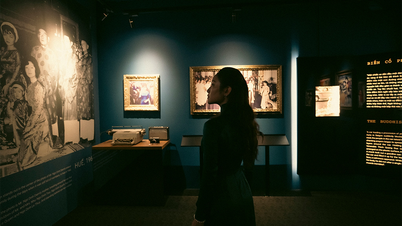
Reg Mead (left) and Richard Miles (right) examine a replica of the Le Câtillon II treasure on display at the La Hougue Bie museum in Grouville. Source: archaeologymag.com
When 70,000 silver coins, 11 gold chains and Celtic jewellery were unearthed in a field in Le Câtillon, Jersey, a British island in the English Channel, in 2012, archaeologists were left baffled. They did not understand why such a huge treasure had been hidden in such an isolated location, far from previously discovered Celtic settlements and trade routes.
After years of research, scientists have found the answer. According to a recent article published in Wreckwatch magazine, the Celts may have inhabited the area, contradicting the previous view that Jersey was a remote and isolated land in the mid-1st century BC.
When the treasure was discovered in 2012, amateur treasure hunters Reg Mead and Richard Miles immediately reported it to Jersey Heritage, an organization responsible for managing historical sites in Jersey. Located in a Crown Dependency, the treasure was processed under the Treasures of England, Wales and Northern Ireland Act 1996, and was purchased by the Jersey government for £4.25 million. The artifacts were then displayed at the La Hougue Bie Museum in Jersey.
Finding treasure in Jersey was no accident – Reg Mead and Richard Miles had been searching the area for 30 years. They began their treasure hunt after hearing from a local woman that her father had found some ancient coins in a field near their home. She couldn’t remember the exact location, and the field owner only allowed them to search once a year, after the harvest. Eventually, their patience paid off.
According to Jersey Heritage, the treasure is six times larger than any Celtic treasure ever discovered. Researchers believe the treasure originated in the ancient Armorica region of France, which is today's Brittany and Normandy, as most of the coins found belonged to a Celtic tribe in France - called the Coriosolitae, whose name comes from the Celtic word "corios", meaning army or regiment.

Painting of Vercingetorix, the Celtic leader defeated by the Romans in 52 BC, throwing his weapons at the feet of Julius Caesar, painted by French artist Lionel Royer in 1899. Source: archaeologymag.com
The treasure was most likely transported amid the chaos of the mid-1st century BC, during the Gallic Wars (58–50 BC, when the expansion of the Roman Empire threatened the autonomy of the Celts in Gaul). Documents from 57 BC describe the Coriosolitae as part of the final alliance against Julius Caesar's army.
The move to Jersey was a desperate attempt to keep the coins out of the hands of the Roman army. “Jersey was probably considered a safer place than hiding these treasures on the mainland of Armorica,” said Dr Phil de Jersey, an expert on Celtic coins.
Researchers conducted the largest geophysical survey ever conducted in the Channel Islands. Using advanced geophysical techniques, the team found linear magnetic anomalies that spanned tens of meters, parallel and perpendicular to each other, some of which resembled rural Celtic settlements of the Late Iron Age in northern France.
These findings support the theory that the treasure was buried in an area where humans were present. Most likely, this was a place for ritual or religious activities. “It is not a coincidence that the Celts chose this location,” commented Dr. Hervé Duval-Gatignol, an archaeologist at the Société Jersiaise (UK). “Treasures of this type were hidden in Celtic temples, and the Le Câtillon treasure could be one of them.” Fear of divine retribution may have been the reason why the people who buried the treasure never recovered it.
Dr. Sean Kingsley, editor-in-chief of Wreckwatch and an archaeologist who has studied more than 350 shipwrecks over the past 30 years, says the Celts were highly inventive sailors and shipbuilders. By the time Caesar attacked Brittany in 56 BC, the Celts were well-versed in maritime trade. Practical knowledge of tides, shoal locations, winds, weather, and landing sites had long been passed down from generation to generation. “They knew exactly how to navigate their ships through rocks and shallow waters,” says Dr. Sean Kingsley.
“Given the dangerous shoals at the entrances to Jersey, it is possible that the treasure was transported in a ship made from animal skins, similar to the gold model discovered in the Broighter hoard in Northern Ireland, which dates back to the first century BC. These ships had a sail, a rudder placed near the stern, with nine oars on each side, to help them weather the fierce winds and keep clear of the reefs. They were also covered with waterproof leather, fastened to a light wooden frame, which at first glance may seem fragile but was actually well-built, light and flexible, suitable for riding the big waves of the unpredictable Atlantic, or for landing in small bays,” he said.
The new findings also raise many questions: Was Le Câtillon a secret mint? Was the treasure a temple offering? Or was it a last-ditch effort to protect tribal wealth? Further research is needed to clarify these questions.
“We think the area was very sacred to the Celts, with ancestral powers dating back millennia, linked to a large Neolithic stone tomb on the hilltop above the site where the treasure was found,” said Dr Sean Kingsley. “There is something very special about these fields. Ancestral spiritual powers may have been the main reason the treasure was brought to Jersey.”
Source: The Guardian, Archeology News Online Magazine
Science and Technology Post No. 1336 (No. 12/2025)
Ngoc Mai synthesis
Source: https://baotanglichsu.vn/vi/Articles/3099/75301/bi-an-ve-kho-bau-khong-lo-tu-thoi-ky-djo-sat.html


![[Photo] Prime Minister Pham Minh Chinh chairs the national online conference on combating smuggling, production and trade of counterfeit goods.](https://vphoto.vietnam.vn/thumb/1200x675/vietnam/resource/IMAGE/2025/6/23/4a682a11bb5c47d5ba84d8c5037df029)




![[Photo] Prime Minister Pham Minh Chinh holds meeting to launch exhibition of national achievements to celebrate 80th National Day](https://vphoto.vietnam.vn/thumb/1200x675/vietnam/resource/IMAGE/2025/6/23/0c0c37481bc64a9ab31b887dcff81e40)

















![[Photo] Party Congress of the Central Internal Affairs Commission for the 2025-2030 term](https://vphoto.vietnam.vn/thumb/1200x675/vietnam/resource/IMAGE/2025/6/23/5bf03821e6dd461d9ba2fd0c9a08037b)









































































Comment (0)